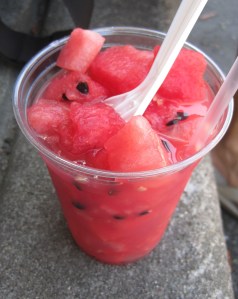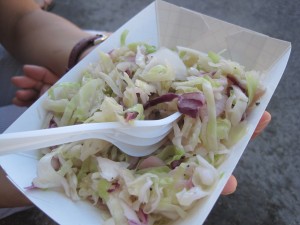Chicagoans tend to have a love-hate relationship with the Taste of Chicago. Traffic, crowds, tourists, long lines for overpriced, mostly underwhelming food — can you tell where I stand? 🙂
But I promise I’m not a festival grinch – I do love the idea of celebrating our city and the food within it, so this year I decided to check out a few of the many other, smaller street fairs on the summer calendar. And I took my camera along…
Andersonville Midsommarfest
Right in our neighborhood!

We sampled the creamy frozen cheesecake, with a coconut-infused crust hidden under the chocolate shell!
Taste of Randolph Street
Known for being the “foodie fest.”

Left: Popcorn shrimp (get it?) with parmesan, chives, and truffle oil. Right: Mac & cheese muffins with smoked gouda and sharp cheddar. Both from Market Bar.
The Raven
We didn’t realize quite how kids-oriented this fest was until we arrived to the sounds of the ABC song being performed with guitar accompaniment on the music stage. Oh well, might as well try some kiddie food…
A quick tip if you’re planning to hit some street fairs: many are advertised as free, but when you get to the entrance it feels like the “suggested donation” of $5 or $10 is mandatory. If you’re on a student (or otherwise small) budget like me, it’s tough to spend that extra cash when the food itself tends to be pricey. So, I suggest being selective about where you want to pony up. For example, I gave a donation at The Raven because it supports local tutoring programs, but at the Taste of Randolph I swallowed my pride and said, “Sorry, I can’t.” That extra $10 meant I could try another dish, which I figure is still a way of supporting local business!
And now for the bonus pic from Taste of Randolph…







